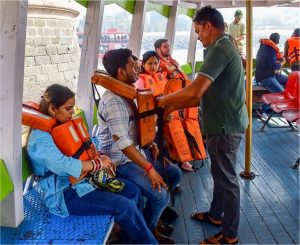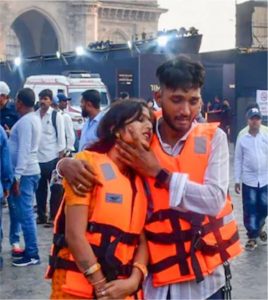 Mumbai, December 19, 2024 — Following a tragic collision between a passenger ferry and a Navy craft off the Mumbai coast, which claimed 13 lives, authorities have implemented mandatory use of life jackets for all ferry passengers departing from the iconic Gateway of India. This decision comes in the wake of the deadly accident involving the overcrowded ferry ‘Neel Kamal’ on December 18, 2024, which resulted in the loss of lives and left many questioning safety measures in place for maritime travel.
Mumbai, December 19, 2024 — Following a tragic collision between a passenger ferry and a Navy craft off the Mumbai coast, which claimed 13 lives, authorities have implemented mandatory use of life jackets for all ferry passengers departing from the iconic Gateway of India. This decision comes in the wake of the deadly accident involving the overcrowded ferry ‘Neel Kamal’ on December 18, 2024, which resulted in the loss of lives and left many questioning safety measures in place for maritime travel.
The Fatal Incident: Overcrowding and Oversight
 The passenger ferry ‘Neel Kamal,’ with a capacity of 90 passengers, was carrying over 100 people at the time of the collision. Official documents issued by the Maharashtra Maritime Board permitted the boat to carry 84 passengers and six crew members, but this limit was evidently violated. According to initial investigations, the ferry capsized after a speedboat, allegedly belonging to the Navy, collided with it during engine trials.
The passenger ferry ‘Neel Kamal,’ with a capacity of 90 passengers, was carrying over 100 people at the time of the collision. Official documents issued by the Maharashtra Maritime Board permitted the boat to carry 84 passengers and six crew members, but this limit was evidently violated. According to initial investigations, the ferry capsized after a speedboat, allegedly belonging to the Navy, collided with it during engine trials.
Eyewitness accounts and survivor testimonies have painted a grim picture of the event. Passengers reported chaos as water began flooding the ferry, with many struggling to find and wear life jackets amidst the panic. One survivor described swimming for 15 minutes before being rescued by another vessel.
The crash has raised serious questions about adherence to maritime regulations and oversight, with police registering a case against the driver of the Navy craft at Colaba police station. Authorities are also examining whether proper protocols were followed by both the ferry operators and the Navy during the incident.
Rescue Operations: A Collaborative Effort
In the immediate aftermath of the collision, a massive rescue operation was launched involving the Navy, Coast Guard, Marine Police, and local fishermen. Eleven Navy boats, three Marine Police boats, and a Coast Guard vessel were deployed to the area. Rescue teams worked tirelessly to evacuate passengers, many of whom were found wearing life jackets, and transported them to various hospitals across Mumbai.
According to the Brihanmumbai Corporation (BMC), over 101 passengers were rescued, while 13 people were confirmed dead, including 10 civilians and three Navy personnel. The injured were taken to hospitals including JNPT Hospital, Naval Dockyard Hospital, Ashwini Hospital, and St. George Hospital, with several reported in critical condition.
New Safety Regulations: Life Jackets and Awareness
As a direct response to the tragedy, authorities have mandated the use of life jackets for all ferry passengers departing from the Gateway of India. This rule applies to those traveling to popular destinations such as Elephanta Island and Mandva, as well as for short rides within Mumbai harbor.
 While the new regulation has been welcomed by many, concerns remain regarding passenger awareness and compliance. Tourists and safety advocates have stressed the need for proper training and demonstrations on using life jackets. “Life jackets are only effective if people know how to use them,” remarked Suyesh Sharma, a tourist from Chhattisgarh. “Authorities should include instructions or demonstrations as part of the boarding process.”
While the new regulation has been welcomed by many, concerns remain regarding passenger awareness and compliance. Tourists and safety advocates have stressed the need for proper training and demonstrations on using life jackets. “Life jackets are only effective if people know how to use them,” remarked Suyesh Sharma, a tourist from Chhattisgarh. “Authorities should include instructions or demonstrations as part of the boarding process.”
Boat operators have also pointed out challenges in enforcing the rule. Sameer Bamane, a boat owner from Bhaucha Dhakka, highlighted passenger reluctance due to discomfort in humid conditions. “Tourists often refuse to wear life jackets here but comply without hesitation in countries like Singapore or Malaysia, where strict enforcement ensures safety,” he noted.
Overcrowding: A Recurring Issue
The overcrowding of ‘Neel Kamal’ has brought the longstanding issue of passenger limits under scrutiny. Despite clear regulations, instances of overloading remain common, driven by commercial pressures and lack of stringent checks. The Maharashtra Maritime Board and local authorities face mounting pressure to enforce stricter controls and penalties to prevent such violations in the future.
Survivor Accounts: Stories of Heroism and Loss
Survivors of the tragedy have shared harrowing accounts of their ordeal. “The speedboat crashed into our ferry, and water started pouring in rapidly,” recounted one passenger. “The driver asked us to wear life jackets, but there weren’t enough for everyone.” Another survivor, who managed to swim to safety, described the panic onboard as passengers scrambled to secure life jackets or find floating objects for support.
Among the deceased were Navy personnel and contractual employees conducting trials on the speedboat. Their families, along with those of civilian victims, have called for accountability and comprehensive investigations into the incident.
Maritime Safety in Focus
This tragic incident has underscored the urgent need for enhanced maritime safety measures. Experts and stakeholders have proposed several recommendations, including:
- Strict Enforcement of Passenger Limits: Regular inspections and heavy penalties for violations.
- Mandatory Safety Drills: Conducting pre-departure safety demonstrations on the use of life jackets and emergency protocols.
- Upgraded Infrastructure: Ensuring all ferries are equipped with adequate life-saving equipment and functioning communication systems.
- Collaborative Oversight: Improved coordination between maritime authorities, ferry operators, and local law enforcement.
A Call for Change
The tragedy has sparked widespread outrage and calls for systemic reforms in maritime safety. Maharashtra Chief Minister Devendra Fadnavis has vowed to take strict action against those found responsible and to implement measures to prevent similar incidents in the future.
“This is a wake-up call for all stakeholders,” remarked Devidas Jadhav, an assistant boat inspector at the Gateway of India. “Safety cannot be compromised, and we must work collectively to ensure that such tragedies do not happen again.”
Looking Ahead
As rescue operations wind down and investigations continue, the focus remains on learning from this incident to build a safer maritime environment. The mandatory use of life jackets is a significant step forward, but sustained efforts in enforcement, education, and infrastructure development are crucial to restoring public confidence in ferry travel.
The incident serves as a somber reminder of the consequences of neglecting safety standards and the importance of proactive measures to safeguard lives. For the families of the victims and survivors, justice and accountability will be paramount as they navigate the aftermath of this devastating event.























































